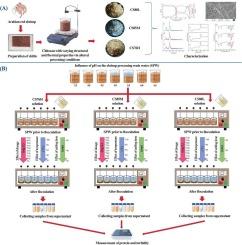壳聚糖的结构和热特性对不同操作条件下虾加工洗水中富含蛋白质生物质回收的影响
Q1 Environmental Science
引用次数: 0
摘要
虾加工厂产生的废水具有高有机负荷,需要在排放前进行处理。研究了不同性质的壳聚糖在不同操作条件下对虾加工洗水中富含蛋白质生物质的回收作用。制备了不同脱乙酰度、分子量和热性能的壳聚糖样品,分别为CS76H(76.14±0.80% DD,高分子量为226.79±0.90 kDa)、CS85M(85.72±1.63% DD,中分子量为38.05±0.33 kDa)和CS88L(88.90±0.57% DD,低分子量为2.84±0.21 kDa)。蛋白质回收的最佳条件为pH 5.5、壳聚糖浓度200 mg/L、温度80℃、沉淀时间60 min。在此条件下,CS85M的浊度去除率最高(99.62±0.20%),优于CS76H(92.19±0.40%)和CS88L(98.51±0.29%)。这种优异的性能归功于它的中等mw和高DD,促进了粒子桥接,静电吸引和蛋白质聚集。所得的上清液具有与清水相当的光学清晰度,表明有效地去除了可溶性蛋白质。差示扫描量热法(DSC)分析表明,CS85M的峰值温度最高(Tp = 314.60°C),表明其具有较好的热稳定性,这与其具有较好的结构完整性和官能团可用性而提高絮凝性能有关。这些结果表明,具有优化结构和热性能的壳聚糖具有高效处理SPW的潜力,为海产品加工部门的可持续废水管理提供了一种有前途的方法。本文章由计算机程序翻译,如有差异,请以英文原文为准。

Influence of structural and thermal characteristics of chitosan on the recovery of protein-rich biomass from shrimp processing wash water under various operating conditions
Shrimp processing plants produce wastewater with a high organic load that requires treatment before discharge. This study investigated the recovery of protein-rich biomass from shrimp processing wash water (SPW) using chitosan with different properties to understand its role under different operating conditions. Chitosan samples with varying degrees of deacetylation (DD), molecular weights (Mw) and thermal properties were prepared, designated as CS76H (76.14 ± 0.80 % DD and a high-Mw of 226.79 ± 0.90 kDa), CS85M (85.72 ± 1.63 % DD and a medium-Mw of 38.05 ± 0.33 kDa), and CS88L (88.90 ± 0.57 % DD and a low-Mw of 2.84 ± 0.21 kDa). Optimal conditions for protein recovery were pH 5.5, chitosan concentration of 200 mg/L, temperature of 80 °C and a settling time of 60 min. Under these conditions, CS85M achieved the highest turbidity removal efficiency (99.62 ± 0.20 %), outperforming CS76H (92.19 ± 0.40 %) and CS88L (98.51 ± 0.29 %). This superior performance is attributed to its moderate-Mw and high DD, which promote particle bridging, electrostatic attraction and protein aggregation. The resulting supernatant had optical clarity comparable to clear water, indicating effective removal of soluble proteins. The Differential scanning calorimetry (DSC) analysis showed that CS85M exhibited the highest peak temperature (Tp = 314.60 °C), indicating superior thermal stability, which correlates with its enhanced performance in flocculation due to better structural integrity and functional group availability. These results demonstrate the potential of chitosan with optimized structural and thermal properties for efficient SPW treatment, offering a promising approach to sustainable wastewater management in the seafood processing sector.
求助全文
通过发布文献求助,成功后即可免费获取论文全文。
去求助
来源期刊

Bioresource Technology Reports
Environmental Science-Environmental Engineering
CiteScore
7.20
自引率
0.00%
发文量
390
审稿时长
28 days
 求助内容:
求助内容: 应助结果提醒方式:
应助结果提醒方式:


